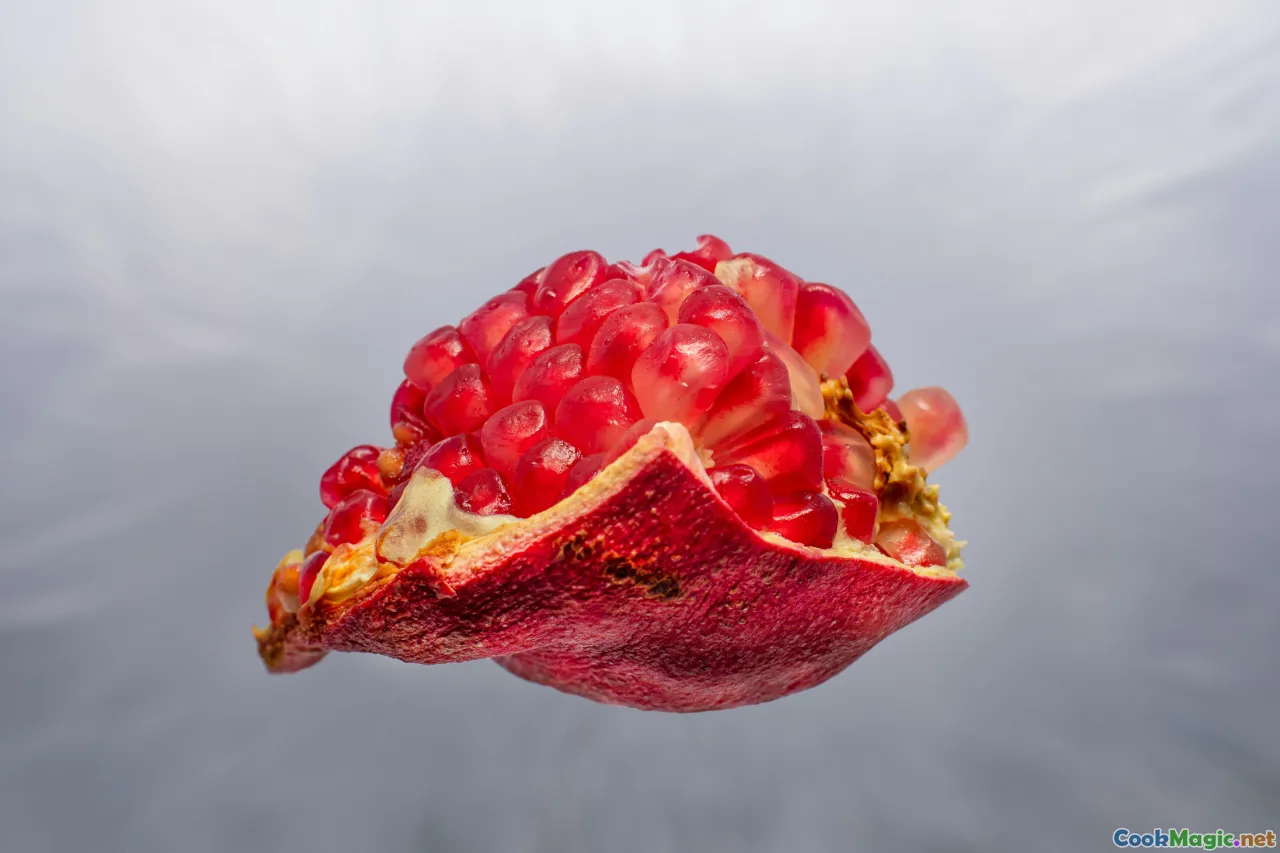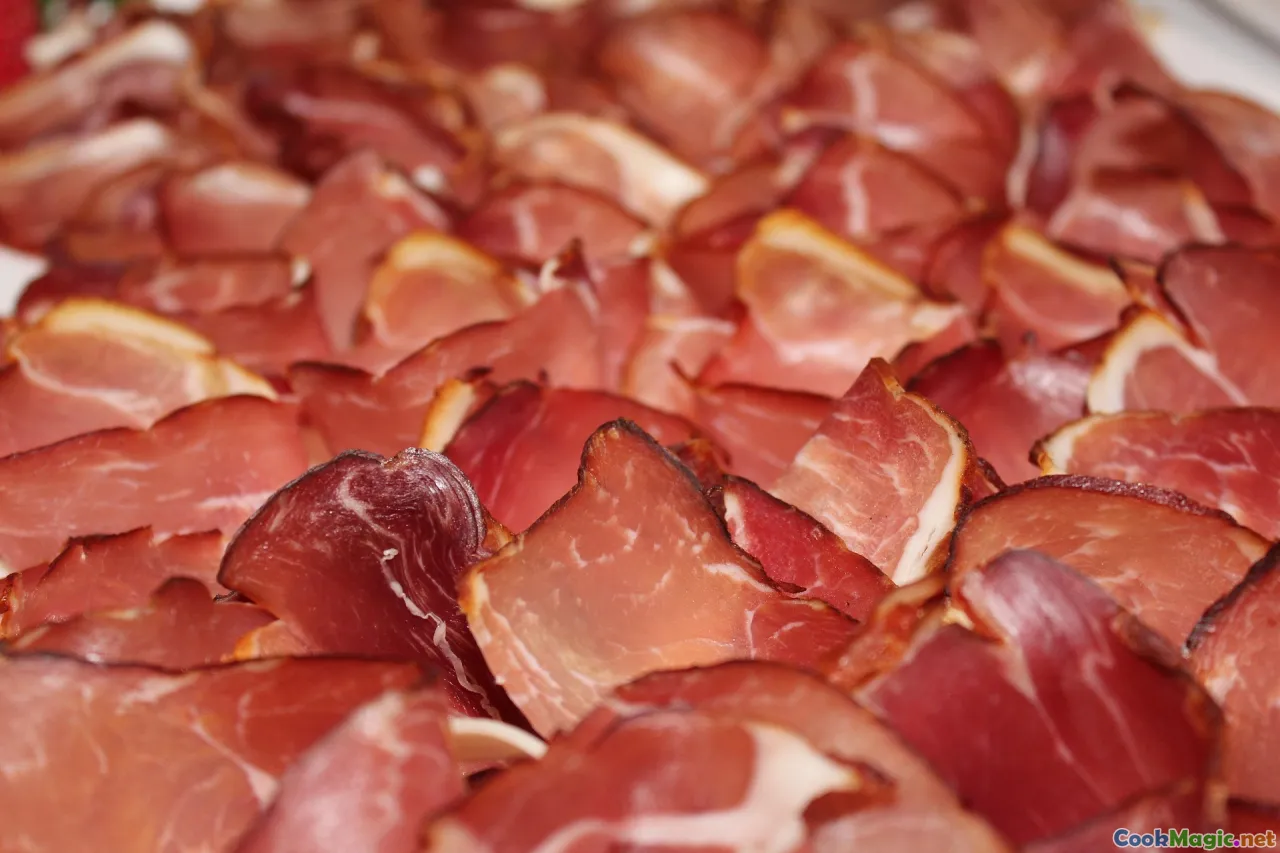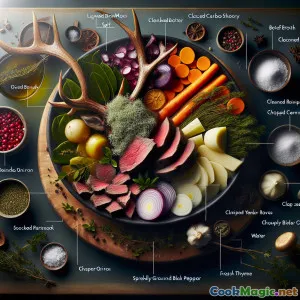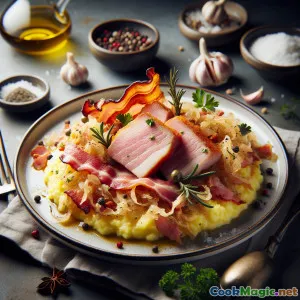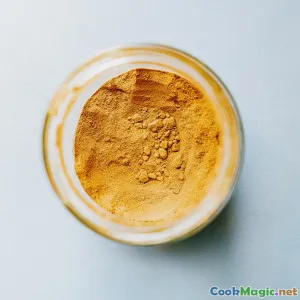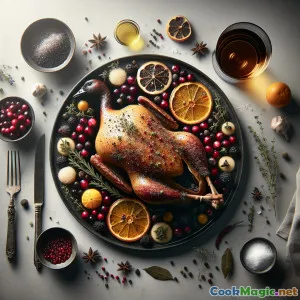
Tundra-Cranberry-gepökelte Gans mit Ahornsirup-Glasur
(Tundra Cranberry Cured Goose with Maple Glaze)
(0 Bewertungen)0
137
Oktober 25, 2025
Problem melden
Zutaten
-
1 whole Wilde Gans, ganz (ausgenommen) und bereit zur Zubereitung
(Approximately 2.5 kg dressed weight)
-
300 grams Frische Cranberries
(Thawed if frozen; for curing paste)
-
120 grams Grobes koscheres Salz
(Essential for curing; do not use fine table salt)
-
80 grams dunkler brauner Zucker
(Balances salt and adds caramel notes)
-
8 grams Wacholderbeeren
(Lightly crushed for resinous aroma)
-
6 grams Schwarze Pfefferkörner
(Cracked, not finely ground)
-
1 Orange Orangenschale
(Wide strips, no bitter pith)
-
6 sprigs Frischer Thymian
(Stems intact for easy removal)
-
3 leaves Lorbeerblätter
(Preferably fresh or soft dried)
-
3 cloves Knoblauchzehen
(Lightly crushed; optional for gentle savoriness)
-
60 ml Gin oder Wodka
(Aromatic boost, Scandinavian touch)
-
120 ml Ahornsirup
(Grade A amber preferred for balanced flavor)
-
30 ml Apfelessig
(Adds brightness to glaze)
-
30 grams Ungesalzene Butter oder Gänsefett
(For glossy, rich glaze)
-
240 ml Wasser
(In roasting pan to catch drippings)
-
60 grams Extra frische Cranberries
(Fold into glaze for tart pops)
-
60 ml Frisch gepresster Orangensaft
(Optional citrus lift in glaze)
-
5 grams Senfsamen
(Subtle bite in the curing mix)
(Approximately 2.5 kg dressed weight)
(Thawed if frozen; for curing paste)
(Essential for curing; do not use fine table salt)
(Balances salt and adds caramel notes)
(Lightly crushed for resinous aroma)
(Cracked, not finely ground)
(Wide strips, no bitter pith)
(Stems intact for easy removal)
(Preferably fresh or soft dried)
(Lightly crushed; optional for gentle savoriness)
(Aromatic boost, Scandinavian touch)
(Grade A amber preferred for balanced flavor)
(Adds brightness to glaze)
(For glossy, rich glaze)
(In roasting pan to catch drippings)
(Fold into glaze for tart pops)
(Optional citrus lift in glaze)
(Subtle bite in the curing mix)
Nährwerte
- Portionen: 6
- Portionsgröße: 1 carved portion (200g)
- Calories: 690 kcal
- Carbohydrates: 0 g
- Protein: 46 g
- Fat: 44 g
- Fiber: 2 g
- Sugar: 16 g
- Sodium: 1150 mg
- Cholesterol: 190 mg
- Calcium: 60 mg
- Iron: 5.5 mg
Anweisungen
-
1 - Trim and Prepare Goose:
Pat the goose dry. Trim excess neck fat, remove any remaining pinfeathers, and prick the skin all over with a skewer, avoiding the meat. Set on a rack over a tray.
-
2 - Make Cranberry Cure:
Pulse cranberries, salt, brown sugar, juniper, peppercorns, mustard seeds (if using), orange zest, thyme, and bay in a processor until a coarse, wet rub forms. Add gin or vodka if using.
-
3 - Apply Cure and Refrigerate:
Rub the mixture inside the cavity and over the skin, coating thoroughly. Place the goose in a large food-safe bag or covered pan. Refrigerate 48 hours, turning once halfway.
-
4 - Rinse and Air-Dry:
Remove goose, lightly rinse off cure, and pat very dry. Return to rack, refrigerate uncovered 12–24 hours to dry the skin and form a tacky pellicle.
-
5 - Roast Low and Render:
Heat oven to 160°C/325°F. Pour water into a roasting pan and set the goose on a rack above it. Roast 60 minutes, basting with rendered fat once or twice.
-
6 - Cook Maple-Cranberry Glaze:
In a saucepan, combine maple syrup, vinegar, orange juice (optional), a ladle of pan drippings, extra cranberries (optional), and butter/fat. Simmer 8–10 minutes until syrupy.
-
7 - High-Heat Finish:
Increase oven to 220°C/425°F. Brush glaze over the goose. Roast 20–30 minutes, reglazing halfway, until lacquered and an instant-read thermometer reads 74°C/165°F in the thigh.
-
8 - Rest and Carve:
Rest 15 minutes to redistribute juices. Carve breasts, legs, and wings. Spoon off excess fat from pan juices and whisk into remaining glaze if desired.
-
9 - Serve:
Brush slices with warm glaze. Serve with roasted roots, wilted greens, or wild rice. Sprinkle a few sea salt flakes and cracked pepper to finish.
Pat the goose dry. Trim excess neck fat, remove any remaining pinfeathers, and prick the skin all over with a skewer, avoiding the meat. Set on a rack over a tray.
Pulse cranberries, salt, brown sugar, juniper, peppercorns, mustard seeds (if using), orange zest, thyme, and bay in a processor until a coarse, wet rub forms. Add gin or vodka if using.
Rub the mixture inside the cavity and over the skin, coating thoroughly. Place the goose in a large food-safe bag or covered pan. Refrigerate 48 hours, turning once halfway.
Remove goose, lightly rinse off cure, and pat very dry. Return to rack, refrigerate uncovered 12–24 hours to dry the skin and form a tacky pellicle.
Heat oven to 160°C/325°F. Pour water into a roasting pan and set the goose on a rack above it. Roast 60 minutes, basting with rendered fat once or twice.
In a saucepan, combine maple syrup, vinegar, orange juice (optional), a ladle of pan drippings, extra cranberries (optional), and butter/fat. Simmer 8–10 minutes until syrupy.
Increase oven to 220°C/425°F. Brush glaze over the goose. Roast 20–30 minutes, reglazing halfway, until lacquered and an instant-read thermometer reads 74°C/165°F in the thigh.
Rest 15 minutes to redistribute juices. Carve breasts, legs, and wings. Spoon off excess fat from pan juices and whisk into remaining glaze if desired.
Brush slices with warm glaze. Serve with roasted roots, wilted greens, or wild rice. Sprinkle a few sea salt flakes and cracked pepper to finish.
Mehr über: Tundra-Cranberry-gepökelte Gans mit Ahornsirup-Glasur
Why this recipe works
Tundra Cranberry Cured Goose channels the flavors of the northern latitudes where geese, juniper, and tart cranberries share the table across the colder months. By applying a fruity, aromatic salt cure first, we gently season and firm the meat while drawing surface moisture away from the skin. The result: deeper seasoning all the way through, a more tender bite, and a skin predisposed to render and crisp in the oven. A final maple-cranberry lacquer brings glossy sweetness and acidity, meeting the goose’s robust, game-lean character head-on with balance instead of bluntness.
Technique highlights
- Drying matters: Air-drying after curing forms a subtle tack called a pellicle. This improves browning and helps the glaze adhere in thin, even layers rather than running off.
- Layered heat: A lower first roast begins rendering fat without scorching the sugars left behind from the cure. The high-heat finish rapidly crisps the skin and sets the glaze.
- Aromatics with purpose: Juniper and orange zest are especially good with waterfowl, providing piney-citrus notes that feel wintry but bright. Thyme and bay contribute savory backbone.
- Smart basting: Baste with rendered goose fat during the low roast—but switch to glazing only at the end. This prevents heavy, greasy layers that repel the lacquer.
Ingredient insight
- Goose: Wild or farmed both work; wild birds tend to be leaner. Trim only excess surface fat; what remains acts as flavor and self-baster.
- Cranberries: Their natural pectin and acidity help the cure cling and penetrate. If using frozen, thaw and drain briefly before pulsing.
- Maple syrup: Choose Grade A amber for nuanced caramel and forest notes; darker grades are fine if you enjoy stronger molasses tones.
- Gin or vodka: A nod to Nordic curing traditions; the alcohol volatilizes aromatics and contributes a crisp, clean finish. Optional, but lovely.
Tips and notes
- Salt type: Coarse kosher salt measures by weight, not volume. If swapping salts, always weigh—120 g is your target.
- Timing: The 48-hour cure and 12–24-hour dry are mostly hands-off. Plan the finish for the day you’ll serve.
- Thermometer cue: Aim for 74°C/165°F in the thigh for safety. Breasts may read slightly lower by carryover as the bird rests.
- Glaze texture: Reduce until it ribbons off a spoon. If it thickens too much while resting, loosen with a splash of hot water or orange juice.
- Fat management: Save rendered goose fat. It’s liquid gold for roasting potatoes, winter carrots, or frying onions for wild rice.
Serving ideas
- Pair with roasted roots (parsnip, carrot, celeriac), braised red cabbage with apple, and nutty wild rice or barley pilaf.
- Garnish with a few candied cranberries or thinly sliced orange peel for color and perfume.
- For a cold leftover service, slice thin and brush with warm glaze; pile into toasted rye with mustard greens.
Cultural and regional notes
Curing waterfowl has roots across northern cuisines—from Canadian Prairie farm kitchens and Métis larders to the Nordic tradition of lightly cured, smoke-kissed game. Cranberries, widespread in boreal bogs, have long brought tart brightness to rich meats. Marrying maple syrup with juniper bridges Canadian pantry staples and Scandinavian forest flavors, presenting a dish that feels both rustic and celebratory. The “tundra” spirit is more about restraint than excess: a handful of powerful ingredients, used thoughtfully.
Make-ahead and storage
- Make-ahead: Cure up to 3 days and dry up to 24 hours. Roast and glaze on the day of service.
- Leftovers: Refrigerate carved meat airtight for 3–4 days. Reheat gently, covered, at 150°C/300°F with a spoon of glaze to keep it moist.
- Freezing: Sliced, glazed goose freezes well up to 2 months. Thaw overnight in the refrigerator.
Variations and substitutions
- Sweetener: Replace maple with birch syrup or a split of maple and honey for different floral notes.
- Spice: Add a star anise or crushed allspice to the cure for holiday warmth.
- Smoke option: After the dry phase, smoke at 120–135°C/250–275°F with apple or alder for 45–60 minutes before finishing in the oven. Keep temperatures food-safe and finish to 74°C/165°F.
Beverage pairing
- Red wines with bright acidity and modest tannins—Pinot Noir, Gamay, or cool-climate Syrah—are excellent. A dry cider or a malty amber ale also complements the maple and cranberries.
Troubleshooting
- Skin won’t crisp: Ensure the bird dried uncovered. If needed, add an extra 10 minutes at high heat at the end, watching closely.
- Too salty: Rinse more thoroughly after curing and let the goose sit uncovered to equalize. Balance on the plate with sweet-acidic sides.
- Pale glaze: Reduce longer, brush in thin coats, and give the lacquer a brief blast under the broiler, monitoring every 20–30 seconds.
This Tundra Cranberry Cured Goose is both practical and poetic: a make-ahead cure that rewards patience with fragrance, color, and a crackling, maple-scented finish. It tastes like winter light through spruce, festive yet grounded, and it makes the kind of centerpiece people remember.


